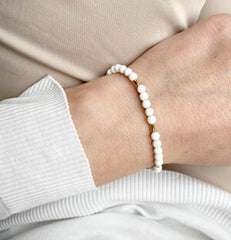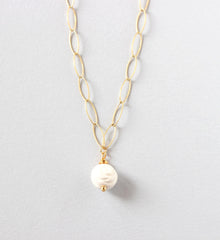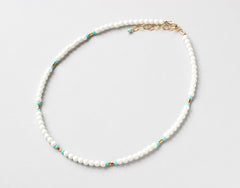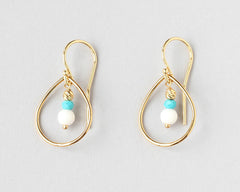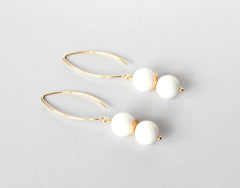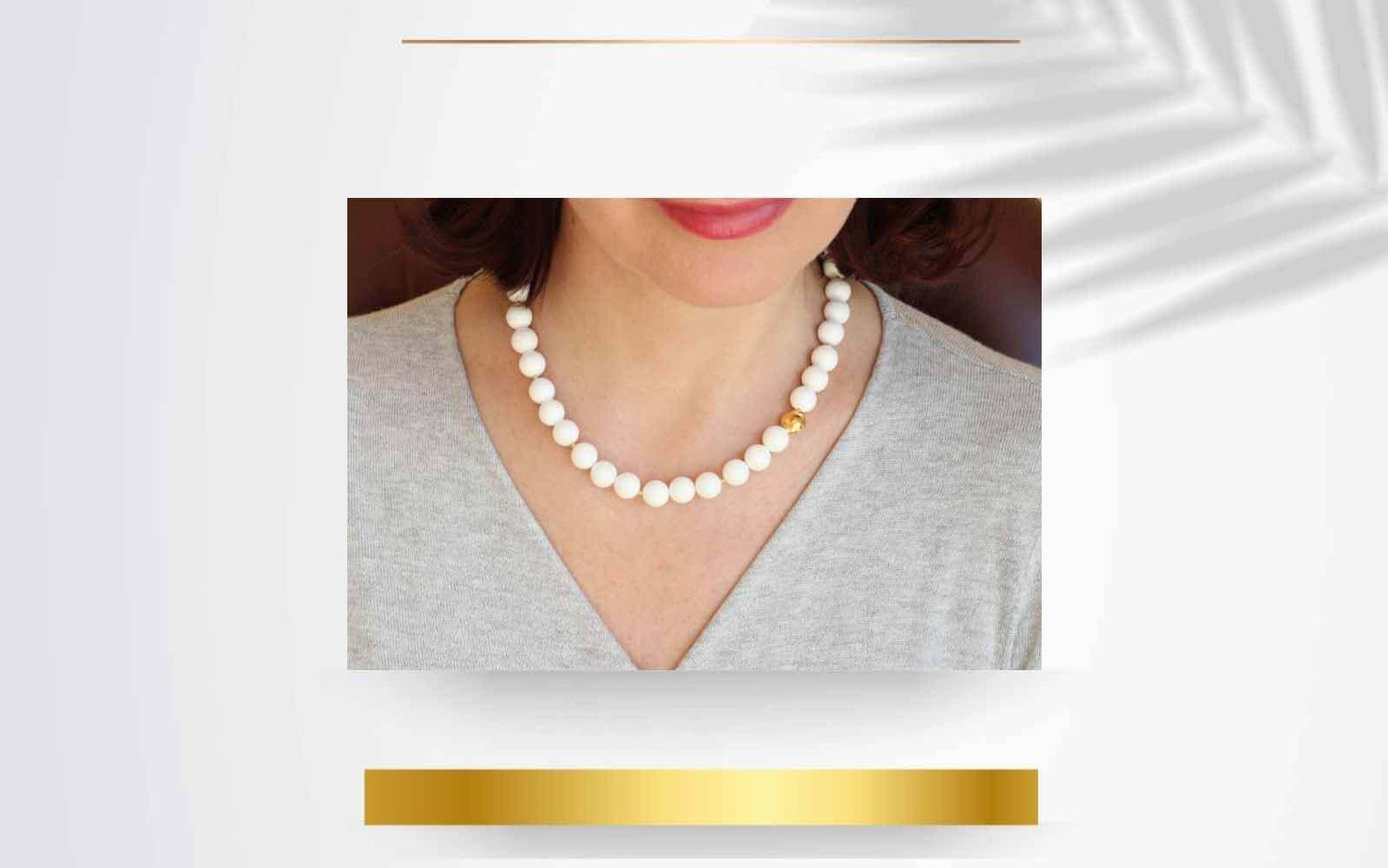
Tridacna - the Giant of the Sea
Tridacna - the Giant of the Sea
Beneath the azure depths of the world's oceans lie hidden treasures, ones that captivate both marine enthusiasts and casual observers alike. These majestic treasures, Tridacna shells, possess remarkable beauty and play a crucial role in maintaining the delicate balance of marine life. Tridacna is known as one of the Seven Treasures of Buddhism and it has always been highly regarded by Buddhists. Tridacna is the inspiration behind our Tridacna gold vermeil collection where the serene beauty of the pure white Tridacna beads combines beautifully with gold. The white beads recall a summery feeling like no other!
Did You Know?
- Tridacna beads are carved from giant clam shells.
- Tridacna is one of the most important spiritual stones for Buddhists.
- Giant-clam fonts grace La Sagrada Familia Basilica in Barcelona.
- Tridacna clams were a staple of the diet, daily life and even deities on the islands of Palau in the western Pacific.
- Tridacna shells can grow up to 4ft and weigh several hundred pounds.
Formation of Tridacna
The giant clams, known as Tridacna, belong to the bivalve mollusc family. These extraordinary marine creatures are among the largest living bivalves. They are found in the warm, shallow waters of the Indo-Pacific region. Pacific Islanders have used these shells as a source of food or have been making useful objects out of them.
The Tridacna genus includes several species, with some individuals reaching sizes of up to four feet in length weighing several hundred pounds and having an average lifespan of over 100 years.
Tridacna beads used in jewellery are carved from these shells. The beads have a beautiful pure white colour with pearlescent sheen.
Tridacna, derived from the Greek words 'tri' meaning three, and 'dakno' meaning to bite, refers to the three distinct openings or siphons present in the clam's mantle.
Cultural Symbolism of Tridacna
Beyond their biological marvels, giant clams hold cultural significance in various cultures, often symbolising prosperity, protection and spiritual connections. Here are some ways in which Tridacna has been used by different societies.
A traditional symbol of wealth - In some Pacific Island cultures, giant clam shells have long been considered a symbol of wealth and prosperity. The substantial size and intricate patterns of the shells make them valuable commodities. Historically in the Solomon Islands, clam shells were converted to a “disc money” form of currency for barter. They have been used as status symbols and even as building materials for traditional structures.
Spiritual significance - The giant clam is valued in certain cultures for its spiritual symbolism. Some believe that the clam's massive shell represents protection and spiritual guidance. In ancient mythology, the giant clam was associated with deities or spirits that watched over the oceans, emphasising the interconnectedness of marine life and human existence.
Decorative and functional uses - The shells' iridescence, unique patterns and durability make them versatile mediums for artistic expression. Throughout history, giant clam shells have been utilised for both decorative and practical purposes. Skilled artisans transform these shells into exquisite carvings, sculptures and jewellery pieces.
The Chinese name for Tridacna, “che-qu,” is mentioned in Buddhist scriptures from the Han dynasty as being one of the seven treasures of Buddhism. A shared belief has been that wearing Tridacna jewellery can calm the spirit and remove negative energy.
Metaphysical Properties of Tridacna
Tridacna has been respected for their beauty, size and rarity. Metaphysical interpretations of Tridacna often draw upon these qualities such as:
Spirituality and tranquillity - The serene nature of Tridacna shells can evoke peace, tranquillity and spiritual harmony. In some belief systems, they may be associated with meditation, mindfulness and finding inner calmness.
Protection and strength - Tridacna shells are large and robust, suggesting protection and strength. Metaphysically, they may be used as talismans or symbols of protection against negative energies or harm.
Connection to the ocean and water element - Being marine creatures, Tridacna shells symbolise the element of water and its associated attributes such as intuition, emotions and adaptability. They may be used in practices related to water magic or rituals involving emotional healing and purification.
Abundance and prosperity - Due to their rarity and value, Tridacna shells can symbolise abundance, prosperity and good fortune. They may be used in rituals or ceremonies aimed at attracting wealth and success.
Harmony and balance - The symmetrical and visually pleasing patterns on Tridacna shells represent harmony and balance in nature. Metaphysically, they may be associated with achieving balance in life, relationships and personal growth.
Rebirth and renewal - In some cultures, shells are seen as symbols of regeneration and renewal. Tridacna shells, being part of the oceanic ecosystem, can represent the cyclical nature of life and the continuous process of growth and transformation.
Connection to the divine feminine - Shells, including Tridacna shells, are often associated with the divine feminine energy, representing qualities such as nurturing, intuition and creativity.
Tridacna’s Conservation Challenges
Despite their ecological significance, Tridacna faces numerous threats that threaten their existence. Overfishing, habitat destruction and climate change pose significant challenges to their long-term survival. Historically, Tridacna were harvested for their meat and shells, leading to population declines in many regions.
Additionally, rising sea temperatures and ocean acidification, attributed to climate change, disrupt the delicate balance of the reef ecosystem upon which Tridacna depend. Increased temperatures can cause coral bleaching events, depriving Tridacna of their primary habitat and food source. Changes in ocean chemistry obstruct the ability of Tridacna to form their calcium carbonate shells, making them more vulnerable to predation and environmental stressors.
Conservation efforts aimed at protecting Tridacna and their habitats are imperative. Marine protected areas, sustainable fishing practices and initiatives to mitigate the impacts of climate change are essential steps towards safeguarding these magnificent creatures for future generations to admire and appreciate.
Conclusion
The giant Tridacna clam, with its inspiring biology, cultural significance and meaning invites us to explore the depths of the ocean's wonders. As we appreciate the beauty of Tridacna, it is vital to consider the importance of conservation efforts to protect these magnificent shells. Their timeless elegance transcends fashion trends, making them a favourite choice for both delicate and statement jewellery. Whether worn casually or for special occasions, our Tridacna jewellery designs radiate sophistication and refinement.
Browse Our Tridacna Jewellery Collection
References:


